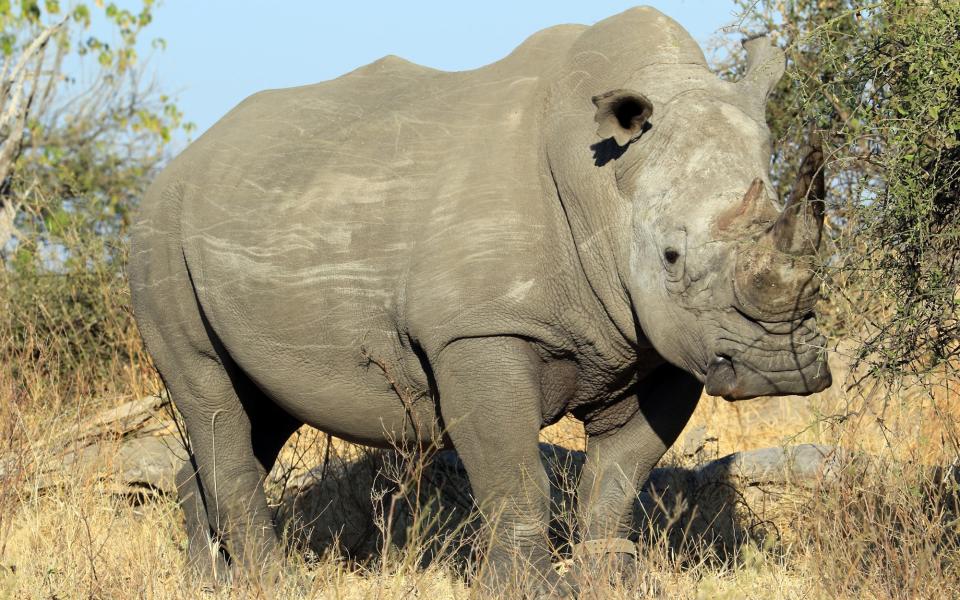Travel on Trial: Picking up poo? You've got to get your hands dirty on a rhino conservation safari

I dipped my hand tentatively into a pile of pungent poo, its lumps the size of cricket balls. Cold and crusty on the outside, they were warm and wet when I broke them up. This wasn’t something I would normally do on safari, but it felt strangely exciting and perfectly normal when on patrol with rhino monitors tracking these behemoths of the bush, a vulnerable species which is very much in the news today – World Rhino Day.
“It’s about an hour old,” said Michael (for security reasons, not his real name), deducing this from its temperature. Michael is a rhino monitor at the beautiful Sanctuary Chief’s Camp in Botswana’s Moremi Game Reserve, which offers guests a morning with its rhino monitoring team, learning all about the animals.
Rhinos fascinate me. Perhaps it’s their gloriously grumpy personalities or their quirky prehistoric appearance, with armour-like hide and huge horns rising like sabres from their snouts. Those horns are the reason they are being poached to the edge of extinction. Worth more than their weight in gold, they’re illogically believed to heal everything from cancer to impotence in traditional Asian medicine, and have become a hideous status symbol for the rich.
At 6am on the day of the track, I found myself wrapped in blankets in the back of a Land Cruiser warding off the morning chill as Michael drove us to a boma, an empty, sturdy enclosure made of logs. He explained that this was the rhinos’ temporary home when they first arrived in Moremi, relocated to relative safety here from the more perilous regions of South Africa where, shockingly, up to three rhinos a day were being killed.

Rhino Conservation Botswana, an NGO, began its ambitious relocation project in 2002. Abercrombie & Kent Philanthropy, which employs Michael, joined in 2015. His job is crucial. Every day, he ventures into the bush to find rhinos, identify them and convey the information to conservationists, building up a picture of their territories and health, and informing future relocation plans. We start to track in the traditional way, looking for spoor (footprints) and scat (droppings), and I am hooked.
travel
This is our first safari. We loved the patrol and found it really interesting to learn so much about this amazing conservation project
Debbie, retired accountant, United States
What might be just dung to you and me is, in fact, the rhino equivalent of social media, letting fellow rhinos know if they’re ready to mate or impinging on territory. Intrigued, I learnt how the shape and contents of dung could help identify its perpetrator.
The midden, or dung pile, we had found was roughly the shape of a children’s blow-up paddling pool. It had been used repeatedly by the same rhino, who had kicked it around, as males do, to spread their territorial scent. Its contents were grass, not sticks, which are eaten only by black rhinos. And nearby lay a footprint the size of a dinner plate, with a clear W-shaped indentation and two lobes at the back, distinguishing white rhino spoor from black.
“This is probably Serjeant, a male white. It’s his territory. He can be very cheeky,” Michael warned. “He gets jealous if he’s with females; he’s even attacked our cars…”
We drove on, following Serjeant’s tracks (somewhat nervously on my part) but lost them on grassy terrain where they were no longer discernible. Then we spotted a notably fat rhino wobbling calmly across the golden plains. “Take a photo of the ears,” Michael said, and we zoomed in to the image on the camera.
All rhinos here have different triangular notches cut into their ears, which are documented on a chart alongside their name, age and gender. Using the chart, we discovered this was Mary. “She’s heavily pregnant,” Michael divulged. “And, unusually for black rhinos, she’s always very calm.” He gave me a data sheet to record our sighting. Instead of stuffy scientific jargon, it had cartoonlike sketches of trees and bushes to signify habitats and drawings of rhino shapes and actions (left), a work of art even a child could complete.

travel
We had no idea the poaching situation was so terrible. It’s great that they’re doing something positive about it.
Eliza, student, United States
• The best honeymoon hotels in Africa
Suddenly, a message crackled over the radio from a guide who had spotted four rhinos some distance away. Our Land Cruiser kicked up scents of wild sage as we bumped hastily through scrub, over rutted tracks and fallen logs, ducking to avoid protruding branches of viciously thorny acacias. The excitement built as we followed clear prints, the frustration palpable when they disappeared.
By 11am, the sun was beating down and these four huge beasts had somehow, somewhere, magically morphed into the bush unseen. “These are the challenges we face on patrol,” Michael said. “On average, we might see rhinos on four days out of seven.”
I was thrilled that we had seen Mary but, in a way, it wouldn’t matter if we hadn’t. What matters is that rhinos are here, alive and well, roaming safely in the wild where they belong.
The rhino monitoring experience costs $200 (£152) per person with all proceeds going to Abercrombie & Kent Philanthropy. Abercrombie & Kent (01242 547702; abercrombiekent.co.uk) offers four nights’ full board at Sanctuary Chief’s Camp from £4,800 per person, including the rhino activity, game drives, all international and domestic flights and transfers.


